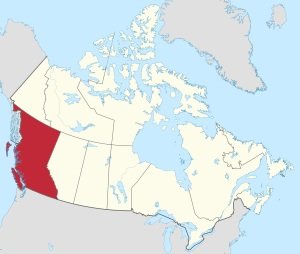The Rural Decline: A Case Study on Canada
Figure 1: Canada and its provinces. British Columbia highlighted in red.
This blog is to briefly discuss the rural decline of Northern British Columbia from a historical view. It shows how the local forest economy boomed from the early 1950s and why the industry has declined since the early 1980s. The long-lasting suffering in the economic transition is mainly due to a lack of consistent aim in the government programs. The main conclusion of this blog on the future rural development is that the economy should not be dominated by a single industry even if the locals have a comparative advantage in that field. A diversified economy can be more stable during the international economic crisis, especially for an economy with huge exports.
Socioeconomic status of Canada
Canada is the world's ninth-largest economy as of 2021, with a nominal GDP of approximately US$2.015 trillion. It is one of the least corrupt countries in the world, and is one of the world's top ten trading nations, with a highly globalised economy. Canada has a mixed economy ranking above the U.S. and most western European nations on The Heritage Foundation's Index of Economic Freedom, and experiencing a relatively low level of income disparity. The country's average household disposable income per capita is "well above" the OECD average (OECD, 2017).
Figure 2: Northern BC’s GDP by sector 2018
Assessment of Urban-Rural Dependency
Even though Canada is a well-developed state, its growth is imbalanced, and research has shown that its rural areas are at a disadvantage in many aspects. For example, as Canada is progressing from a resource-based economy into a knowledge-based economy, reports suggest that, by the year 2031, roughly 70 to 80 percent of jobs in Canada will require some form of post-secondary education (PSE), rendering skilled workers a vital commodity. However, Zarifa et al., (2019) show that rural residents aspire and obtain lower levels of education than their urban counterparts, even after controlling for a host of socio-economic factors at the individual and family levels. They are less likely to attend university, as opposed to community college and less likely to enrol in university-level STEM fields.
The skill shortages produced by these uneven migration flows hinder the economic development of many rural and northern communities, especially those that sit on natural resources, whose extraction and processing requires a highly skilled workforce. As people is one of the main rural provisioning ecosystem services, the lack of skilled people will decrease the effectiveness of human capital.
Key findings
British Columbia (BC) is a western province of Canada. The current economic structure of BC is well diversified. However, before its economic transition in the 1990s, its economy was highly based on natural resources and mainly focused on the forest industry. Although the resource economy helped the local economy thrive in the early 19th century, it also made the economy vulnerable to the fluctuating international raw material price. Here, we first show how BC’s forest economy boomed because of the increasing global demand for forest products,how the forest industry struggled in the transition during the recession in the 1980s and how the government failed to deal with the problem.
Early booms
Until the early 1980s, due to the BC's expanding resource industry (mainly on forestry) based across most of the non-metropolitan parts of the province, the rural areas of BC experienced rapid population growth through in-migration of young adults and high fertility (Hanlon & Halseth, 2005). The resource endowment served as the foundation for the economic prosperity of BC. It has a long history of providing forest-product commodities. After the construction of transcontinental railroads in the late 1880s and the opening of the Panama Canal in 1914, BC gradually became a large supplier of forest-product commodities (lumber) to the US, Europe, and Japan. The policy of Sloan's Commission has further enhanced the growth of the resource industry since 1945. The industry started to transform from Entrepreneurism to Fordism. Corporate integration started, and then large firms dominated the industry. Supply increased due to the economics of scale, and all different resource industries experienced high growth rates, supported by the increasing demand from the post-WWII reconstruction. Also, the government implemented a supportive policy to facilitate the sustainable development of the forest industry (Hayter, 2007), which included:
Provided tree farm licences to the large firms and set the threshold of cutting allowable annual cut (AAC), which guarantees that the natural growth rate of timber exceeds the harvesting rate in the long term.
Allowed unrestricted foreign direct investment and considerably invested in the infrastructure, especially on the extension of rail, road, and power network.
Created instant resource towns to offer social and community services, stabilise the workforce and secure local economic investment.
During this stage, natural resources acted as the engine for economic growth. The global demand for forest-product commodities dramatically increased after WWII, and new technology (Fordism) boosted the supply. The government policy further enhanced the fast and sustainable growth of the resource industry. The sporadically settled hinterland was transformed into an integrated economic landscape. However, as will be illustrated later, the unitary structure of the local economy, which highly depends on the export of minimally processed raw materials, makes itself vulnerable to the global commodity demands and prices.
Recessions from the 1970s
In the 1970s, the world experienced two energy crises. The prolonged recession that started in 1980 resulted in a more volatilized forest industry. The market price and demand dramatically fluctuated, resulting in a requirement for a more flexible production style. The flexibility requires intensive use of technology and fewer employees to keep 'per unit' production costs low. The crisis was exacerbated by increasing competition from low-cost global competitors. By 1981, the economic restructuring resulted in massive layoffs and closures. The unemployment rate in the resource industries was 19.2% in 1982.
This crisis had been exacerbated by a variety of additional forces, including environmental debates, consumer demands for more specialised products, continuing demands for low-cost products, increasing relative labour costs, and increasing competition from low-cost global competitors. In BC, restructuring had also accelerated because of on-going trade disputes with the United States over softwood lumber and ideological shifts in resource policies by successive provincial governments (Hayter, 2003). Therefore, resource companies were aggressively restructuring towards a more ‘flexible’ style of production (Hayter, 1997). This often included larger plants with increased levels of technology and fewer employees to keep ‘per unit’ production costs low and production flexibility high (Hoekstra, 2002). For towns and communities which had thrived under the high employment regimes of resource industry production from the 1950s through to the 1980s, there had been considerable social and economic impacts associated with the transition.
Layoffs and closures associated with resource industry restructuring soon meant that northern BC began to lose population for the first time since WWII. In addition to population losses, restructuring has also had a significant effect upon the region’s population age structure. In the 1960s and 1970s, large numbers of industrial jobs attracted young workers and their families. By 2006, there had been a considerable transformation in the region’s population structure. The working age population has ‘aged in place’ because of limited new expansion to the industrial base. This lack of new job creation limited the opportunities for high school graduates and young people to enter the workforce. Together, the age structure now shows an older workforce and relatively fewer young people. This population ageing suggests a future potential challenge to health care and community support services.
Government’s policies
The policy response during this period may be best characterised as state withdrawal in both social and economic terms. Starting in the 1980s, the federal government began closing rural post offices, employment insurance offices, and human resources offices. Federal government cutbacks in transfer payments to the provinces have meant a reduction in health and education services in smaller communities. The provincial government has closed/reduced health services and ministry offices. In addition to these direct cuts, a trend towards off-loading has meant that some basic infrastructure, such as schools, courthouses, or road maintenance, is no longer being carried by the provincial tax base. The increasing application of urban-based models of efficiency and market parameters are unsuited to the needs and realities of rural places and rural geographies. Service closure through the application of inappropriate models directly affects rural and small-town sustainability.
The lack of consistent policy also limits the performance of economic recovery programs. The BC governments have experimented with a variety of regional development programs and entities since the mid-1980s. In each case, initiatives failed to survive beyond a three- to five- year period as changes in governments brought shifting priorities. This lack of consistency runs counter to the long-term realities of the development process. As a result, impacts were limited, sporadic, non-cumulative, and their (potential for) success never fully assessed. From a macro policy orientation, successive BC governments since the early 1980s, regardless of political orientation, continued to endorse and reinforce large scale industrial resource development policy.
Conclusion
Highly concentrated on the resource industry created economics of scale at first. However, the booms could only be maintained by a strong demand. The high dependence on raw forest-product commodities made the local economy easily impacted by the global markets. Layoffs and closure of factories happened when the energy crisis and more intensive global competition influenced the local industry. With the further withdrawal of public and private services, depopulation was inevitable.
The lesson from the example is that even if the natural resource in the rural areas can be used as an engine for its economic boom, the local economy should not be too concentrated. The development of other industries should also be considered to add diversity to the economy and increase its adaptivity. Also, during the contractionary economic shock, the government should not act passively, resulting in a long-lasting recession.


